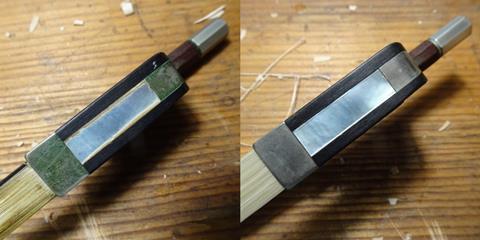Instilling good, daily habits is the key to your bow’s health, writes Suzy Schmitt from the Women in Lutherie community
Discover more lutherie articles here
Your bow needs taking care of as well as your instrument. There are several aspects that you can check yourself without the need of a professional.
As a bow maker, the first piece of advice I give out on a daily basis is to loosen your bow hair every time you have finished using it. If you play a wooden bow it is even more important to do so in order to keep the camber of the stick even. If you keep your bow hair tight all the time, you risk breakage.
When using your bow, feel how it reacts: is the mechanism working smoothly when tightening it? If not, you can take out the screw and put some dry soap on it. When you take out the screw, hold the frog onto the bow stick with one hand to keep it in place while rubbing the screw on the soap with the other.
Use a dry and clean cloth to take off the rosin and sweat from the stick and the frog on a regular basis.
Look at your bow hair: it needs to remain evenly white. Make sure to keep your hands off the hair when using the bow. When you put your fingers on the hair, it may create greasy patches. Rosin will not stick very well to those areas.
Keep your instrument bow far away from any heating source and do not leave your bow unattended in a car.
It might sound obvious but a bow needs to be handled with great care as it is very fragile. When you take a break or when you are finished playing, your bow should not be stored on a stand, a chair, a bed, etc. Always put it in a safe place like its case.

Read: Looking after your instrument: a guide to cleaning and polishing
Read: Looking after your instrument: the secret to bridge placement
Read: Looking after your instrument: a beginner’s guide on how to change your strings
Discover more lutherie articles here
When to see your bow maker:
You may feel that you cannot get your bow hair to a playable tightness anymore. You can unscrew the button keeping it pushed in the bow stick until it starts pushing itself out. That means the frog has gone to its minimum position. At that stage you can stop unscrewing and look at your bow holding it horizontally with the hair up. If your hair is long enough to represent a big curve that reaches underneath the bow stick in the midddle area, that means that the bow hair is too long for the mechanism’s length.

On the contrary, if you can unscrew to the maximum the bow mechanism but the hair still remains tight, that means that the hair length is too short. In both cases: too long or too short, you will need your bow to get rehaired by a professionnal as soon as possible.
You can also sometimes see a dark area on the hair next to the frog. That means that the hair is getting old and dirty. If the rosin doesn’t stick on the hair easily anymore, this is another sign of old, dirty hair: it is time to go visit your local bow maker for a rehair!
The best way to keep your bow happy, as well as keeping a close eye on it, is to regularly visit your bow maker to have it checked out and rehaired. I recommend once a year. Nice fresh hair makes a lot of difference to the playing.
If you have any problems understanding something that troubles you with your bow, your bow maker will be able to answer your question and offer a solution.
All photos courtesy Suzy Schmitt
Originally from Alsace, Suzy Schmitt graduated from the Newark International School of Violin Making. She maintains a workshop in Le Mans, France, focusing on bow making and restoration. Find out more here: www.suzyarchetiere.com
Read: Looking after your instrument: Fingerboards demystified
Read: Looking after your instrument: an introduction to soundposts
Discover more lutherie articles here
Best of 2022: The Strad’s 12 Days of Lutherie
- 1
- 2
- 3
- 4
- 5
- 6
- 7
- 8
- 9
- 10
- 11
 Currently reading
Currently readingLooking after your instrument: a guide on caring for your bow
- 12
- 13






















































No comments yet